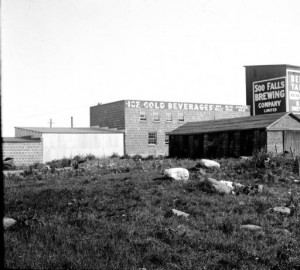
Northern Breweries Ltd. was a Canadian brewing company founded in 1907 by the Doran, Mackey, and Fee families. Located in Northern Ontario the company played a significant role in many northern communities and the built history of these facilities are still being considered locally.
The company originally started in Sudbury as the Sudbury Brewing and Malting Co. in 1907. They later expanded throughout Northern Ontario by purchasing Soo Falls Brewing Co in Sault Ste Marie in 1911, Kakabeka Falls Brewing Co. in Fort William in 1913, in 191 they established a division in Timmins, and in 1948 they purchased the Port Arthur Beverage Co.
Prior to 1960 each of these breweries operated under their independent names. In 1960 they were amalgamated and became collectively known as Northern Breweries. Each of these local operations have distinct community based histories but the Northern Breweries company as a whole also has a history that has implications outside of the communities it operated in.
From 1942 to 1992 the breweries eventually known as Northern Breweries had a monopoly on draught beer in Northern Ontario. If you were at a bar in the North and asked for a pint you got Northern Breweries beer. The first 30 years of this monopoly was provided by an agreement amongst brewers and the LCBO. The last 20 years of protection was mandated under Ontario provincial legislation.
The Second World War resulted in the protected Northern Ontario draught market. The Wartime Alcoholic Beverages Order limited brewery production and to limit transportation resources in May 1942, wide distribution of beer in Ontario and Quebec was prohibited. Specifically, the order proclaimed,
No brewer shall sell or offer for sale or deliver any draught beer, ale, stout or porter which has been brewed in any brewery in the Province of Quebec or in any part of Ontario lying to the south of the 46th parallel of latitude, to any retail liquor store or place which is situated in any part of Ontario lying to the north of said parallel of latitude.
A similar provision prohibited breweries north of the 46th parallel from selling to the south. This measure effectively ensured the protection of Doran’s draught market. When WWII ended the Wartime order ceased however brewers and the LCBO continued to respect the artificial line separating Northern Ontario from Southern Ontario brewers.[i]
This informal agreement was brought into question in the 1970s with the sale of Northern Breweries to Canadian Breweries Limited. This sale fundamentally changed the ‘gentlemen’s agreement’ and Southern brewers indicated new interest in selling in the North.
In 1972 Arthur Wishart authored “Report of the Inquiry Into the Brewing Industry, Northern Ontario by A.A. Wishart” on the daught brewing industry in Northern Ontario that looked at the economic and social impacts of opening the North to competition. Brewing in the North came a point of public debate. The report emphasized the geographic nature of Northern Ontario and the high cost of shipping draught beer to the North, suggesting that the Southern brewers had little to gain from Northern expansion.
The fact that in 1972 the Ontario government passed legislation that essentially made Doran’s Northern Breweries a monopoly in the North is somewhat unusual. The main argument for keeping the monopoly was the need to preserve Northern Ontario jobs and the potential negative socio-economic that allowing draught competition would bring. It also highlighted the contributions from the North to Provincial and Federal coffers and Doran’s submission to the report emphasized the role of the brewer in Northern communities and its place as a good ‘corporate citizen.’ Ultimately the monopoly was preserved because the Ontario government was “committed to a policy of encouraging industry to locate in northern Ontario.” Regional development took precedence over free enterprise.[ii]
Even with the protected draught market Doran’s sales began to drop. Coinciding with this decline in sales, in 1977 employees of Doran’s Northern Ontario Breweries purchased the Company from Canadian Breweries becoming the first employee owned brewing company in North America. Under this new leadership the company began to market outside of Northern Ontario. In the 1980s craft brewing also developed in Ontario creating a whole new set of regulatory discussions on the provincial level.
By the 1990s Northern businesses wanted to offer a wider range of draught beer. Starting in 1991 licensees were able purchase draught outside of the North if they transported it themselves. In 1992 the draught market in Sudbury was opened to all brewers, the rest of Northern Ontario followed in 1993.
The 1990s saw the decline of Northern Breweries sales even further. A revival of the company was attempted in 2004 when it was purchased and rebranded by an investment group. But in 2006 Northern Breweries closed its doors for the last time.
Today, many of the communities which housed Northern Breweries buildings are considering how to preserve this part of their local labour history. In Sault Ste Marie, Riversedge Developments purchased the historical ‘Brewery Block’ and is in the midst of tearing down parts of the building and working on adaptive reuse plans for other portions of the site. Right now the Soo Falls brewing stack still stands as a reminder to locals of the rich brewing history in Sault Ste Marie.
[i] Daryl White. “Draught, Development, and Discourse: The Northern Ontario Draught Beer Monopoly, 1972-92.” Journal of Canadian Studies/Revue d’études canadiennes 47, no. 2 (2013): 5-28.
[ii] Wishart, A.A. 1972. Report of the Inquiry Into the Brewing Industry, Northern_Ontario. by A.A. Wishart Q.C. n.p.: Toronto: : s.n, 1972., 1972.
